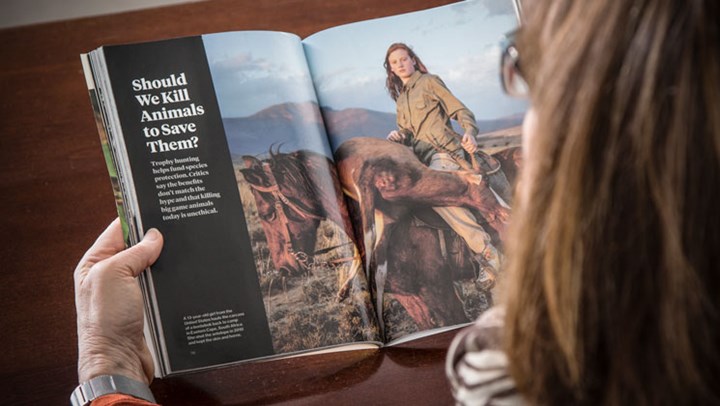
by Frank Miniter - Thursday, November 2, 2017

Michael Paterniti, a contributing writer at the New York Times Magazine and a correspondent for GQ magazine, along with photographer David Chancellor, teamed to answer a question for National Geographic: “Should We Kill Animals to Save Them?”
I read the 6,000-word feature with trepidation and interest, as I have seen firsthand how hunting brought wildlife back to so much of South Africa and Namibia. I’ve seen ranchlands that had little plains game left on them in 1960s that today are teeming with kudu, wildebeest, springbok, gemsbok … all because local landowners discovered that game animals aren’t just competition for their cattle and other livestock, but that hunters will pay a lot for a chance to hunt these species.
The article is surprisingly thoughtful and a delight to read. But it just falls short of real honesty.
After asking almost all the right questions from differing perspectives, the sprawling feature concludes a narrative it began at the beginning in which an American hunter goes with a PH and trackers, day after day, until he finally kills a massive bull elephant.
The author writes:
I thought about those tusks in the weeks that followed, possessions now, totems of a fraught accomplishment. They were all that was left of two 15,000-pound sentient beings. Which brought me to Bobo Tsamkxao, the San chief, and his wives and children, and how they and others in the community would eat from those animals. And how they would receive money, at least indirectly, from those animals as well. But something still seemed askew: a paying client killing a vulnerable animal to feed the San or conserve Nyae Nyae’s land. Even if hunting is in our genes, as Denker said, the essential question remained: Was it moral to kill such an imperiled creature at this moment in our history?
After the hunters had packed up, the herds—sometimes called a “parade” of elephants, or even a “memory” of elephants—searched for water in temporary peace, unaware that another season would bring another group of hunters. We must imagine: Memories of elephants wandering all that contested space, some already with price tags on their head, there for us as things of wonder.
Did Paterniti, in the end, feel he had to conclude with an ending his editors at the New York Times Magazine would accept?
So honest at times, yet this dead end leaves real questions unanswered. It is a dodge. Every population of game animals, from whitetail deer to elephant, must deal with predators. If they don’t, they overpopulate and destroy their own habitat and thereby harm other species.
Paterniti quotes a lot of numbers, estimates from various sources, on how much money traveling hunters pour into rural areas of Africa and more. He compares hunting expenditures to those raised from non-hunting wildlife tourism. (You may recall the article “Trophy Hunting Is Good For Conservation Says IUCN Report” from April 2016 citing in-depth research revealing that it is hunting, not photo safaris, that bring in much needed funding to communities and wildlife conservation that photo safaris do not reach.) He notes, from sources in Africa, that photo safaris aren’t a viable business model in much of rural Africa. He quotes wildlife professionals, some who clearly would prefer hunting wasn’t necessary, who tell him there just isn’t a better way than hunting to protect vulnerable wildlife populations from poachers.
But then he never asks a key question: How can the killing, via legal hunting, of just a very small percentage of mature animals from a herd imperil an overall population of elephants or other game animals?
Clearly, given the economic incentive hunting brings, wildlife populations can and do benefit from being hunted in Africa and all over North America.
He almost addresses this critical point several times by noting that hunting the “Big Five” and animals someone has “named,” such as “Cecil” the lion, can elicit strong emotional reactions from people. But he fails to note that legal hunting is not threatening these species. It is the poachers who are massively impacting wildlife populations for meat or for the ivory or bone black markets.
In some countries, corrupt officials can be a problem. Again though, it is not hunters or hunting. The problem is illegal activity and corruption. Instead of tacitly acting as if law-abiding hunters are aligned with those criminal elements, Paterniti should have used this great opportunity to note that hunters are conservationists whose goals for healthy ecosystems and animal populations illustrate how much hunters truly care about our wild resources.
Still, though I have given Paterniti a hard time here, he almost got there. A few decades ago it would have been hard to imagine a writer for The New York Times letting this much honesty flood into his prose about something as politically incorrect as hunting.
Now, if we can just take those last few steps, we can come together and put the pressure where it should be: on corrupt officials and poachers in Africa and elsewhere. Now wouldn’t that be a hell of a thing?
E-mail your comments/questions about this site to:
[email protected]
Proudly supported by The NRA Foundation and Friends of NRA fundraising.
